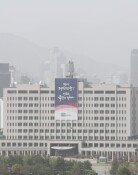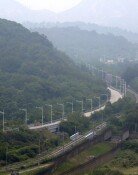Delayed reporting aggravates oil spill damage in Yeosu
Delayed reporting aggravates oil spill damage in Yeosu
Posted February. 05, 2014 07:51,
It looks like an accident has happened at the crude oil pier in Yeosu.
A report was filed to the Vessel Traffic Service System at the Yeosu Regional Maritime Affairs and Port Administration at 9:57 a.m. last Friday, or the Lunar New Years Day holiday. It was 22 minutes after the accident occurred. The informant was an official with the Yeosu pilots association, not a crew member of the tanker Wu Yi San (registered in Singapore) that caused the oil spill, or staff member of GS Caltex, the company in charge of facilities at the pier. A pilot works to guide large vessels to navigate at a port and anchor in the pier safely.
The pilot identified by his last name Kim who was aboard the Wu Yi San, or staff members of GS Caltex made internal reporting on the oil spill from the ruptured oil pipe via wireless communication, but failed to immediately report it to the disaster prevention authority.
In police investigation, crew members of the troubled tanker reportedly said, Reporting to authorities were delayed as we sought to pull out the hull of the vessel that hit the oil pipe. GS Caltex employees also said they made reporting 30 minutes after the accident occurred, because they worked to shut off values to the oil pipe. However, critics say that those involved in the accident aggravated damage because they failed to follow the crisis response manual for marine pollution, which suggests "An accident must be reported to disaster prevention authorities immediately."
The Yeosu Coast Guard is investigating testimonies by GS Caltex employees suggesting that it took 33 minutes for them to completely close the value to the oil pipe. The time when the valve was completely shut off determines the volume of crude oil spilt and magnitude of resulting damage.
Critics also say that the Korea Coast Guard, which is in charge of overall disaster prevention, also might have ended up increasing damage because it blindly believed GS Caltexs initial claim that the amount of crude oil spilt was 800 liters. On the day of the accident, a total of 74 vessels, including 20 Korea Coast Guards patrol boats, were mobilized to contain damage from the leak, but the number of ships deployed significantly increased to 127 on Saturday, 406 on Sunday, and 582 on Monday. In fact, the Korea Coast Guard estimated the volume of leaked crude oil at some 10,000 liters, but beefed up efforts to contain damage after adjusting its estimate to 164,100 liters on Sunday. It has been also revealed that the Navy, which reportedly sprayed emulsifying agent, did not even participate in the disaster prevention taskforce.
Lee Seung-yeong, chief of the maritime safety facility division at the Yeosu Regional Maritime Affairs and Port Administration, said, Damage increased because automatic values that can immediately shut off crude oil leaks did not operate at the time of accident due to power blackout, adding, We are considering installing an emergency power supply system for oil pipes just like a chemical complex.







